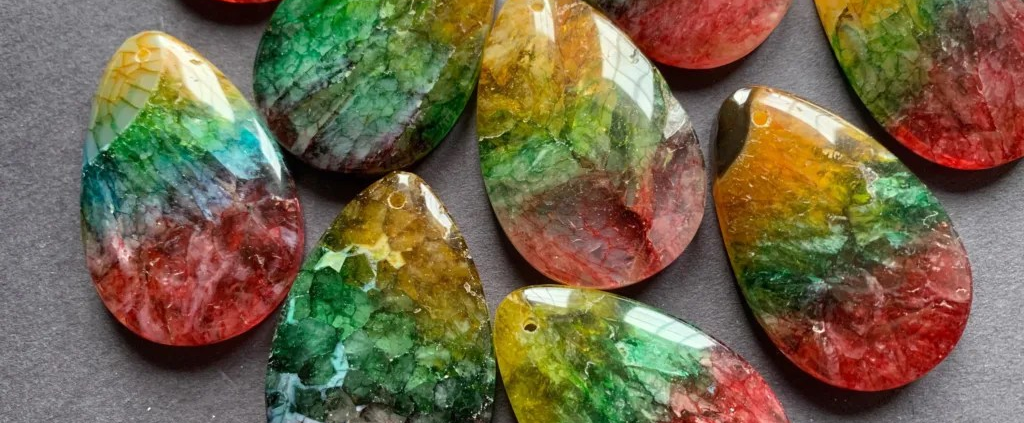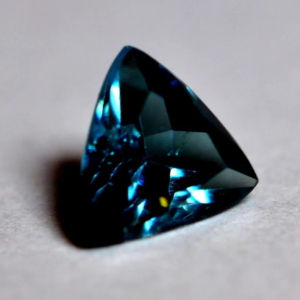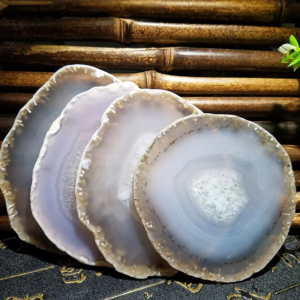Crackle Quartz
Crackle Quartz is a unique variety of quartz crystal that has a distinctive cracked or shattered appearance within the crystal structure. This distinctive crackled effect gives the quartz a captivating and visually striking appearance, making it a popular choice in the world of gemstones and crystal healing.

Definition and Brief Description: Crackle Quartz is a type of quartz crystal characterized by the presence of numerous internal fractures or cracks that create a beautiful, intricate network of lines throughout the stone. These cracks can vary in size and pattern, resulting in a range of unique and eye-catching designs within the crystal. The cracks are often filled with other minerals, creating colorful and visually appealing inclusions.
Crackle Quartz is usually transparent to translucent and can occur in various colors, including clear, white, smoky gray, or even in vibrant shades like blue, green, and pink. This stunning appearance is primarily a result of heat treatment and enhanced by the infusion of other minerals or dyes during the process.

Significance and Uses:
- Aesthetic Appeal: Crackle Quartz is highly prized for its aesthetic beauty and unique appearance. Its shattered patterns and vibrant colors make it a popular choice for jewelry and decorative purposes, such as in pendants, earrings, and ornamental carvings.
- Energy and Healing: In the world of crystal healing and metaphysical beliefs, Crackle Quartz is thought to possess various healing properties and energies. It is often associated with enhancing clarity of thought, concentration, and focus. It’s believed to help release emotional blockages and promote emotional healing by breaking through barriers, much like the cracks in the crystal itself. Additionally, its different colors may be associated with specific chakras and energy centers in the body, allowing for targeted healing work.
- Meditation and Spirituality: Crackle Quartz is used by some individuals during meditation practices to enhance spiritual growth and self-discovery. Its unique appearance is thought to symbolize the breaking of old patterns and the emergence of new perspectives and insights.
- Decorative Purposes: Apart from jewelry, Crackle Quartz is also used in home decor, where its vibrant colors and intricate patterns add a touch of elegance and mystique to interior design.
- Gifts and Collectibles: Crackle Quartz items make for thoughtful and visually appealing gifts, especially for those interested in crystals, gemstones, or spiritual practices.
It’s essential to note that the significance and uses of Crackle Quartz are primarily based on belief systems related to crystal healing and metaphysics. Scientifically, it’s considered a visually appealing variety of quartz with unique patterns caused by internal fractures and heat treatment.
Contents
- How Crackle Quartz is formed
- Geological locations where Crackle Quartz is found
- Physical Characteristics
- Mineral Composition and Trace elements and their effects on color
- Uses of Crackle Quartz
How Crackle Quartz is formed

Crackle Quartz, also known as Fire Quartz or Crackled Quartz, is formed through a specific process that involves heat treatment and sometimes the infusion of other materials. Here’s a step-by-step explanation of how Crackle Quartz is typically formed:
- Selection of Quartz Crystal: The process begins with the selection of high-quality natural quartz crystals. These crystals can come in various colors and varieties, including clear quartz, smoky quartz, or even amethyst.
- Heat Treatment: The selected quartz crystals are subjected to heat treatment. During this process, the crystals are exposed to high temperatures, usually in the range of 800 to 1600 degrees Celsius (1472 to 2912 degrees Fahrenheit). The exact temperature and duration of heating can vary depending on the desired outcome and the type of quartz being treated.
- Rapid Cooling: After the crystals have been heated to the desired temperature, they are rapidly cooled. This rapid cooling process causes the internal fractures or cracks to form within the crystal. The cracks are typically caused by the differential expansion and contraction of the crystal’s components during heating and cooling.
- Infusion of Other Materials (Optional): In some cases, additional materials may be infused into the cracks or fractures during the heat treatment process. These materials can include dyes, minerals, or metals, which add color and sometimes metallic luster to the cracks. This step is optional and is used to create Crackle Quartz with vibrant and varied colors.
- Cutting and Polishing: Once the heat treatment and crack formation process is complete, the treated quartz crystals are cut into various shapes and sizes, depending on their intended use. They are then carefully polished to enhance their visual appeal and shine.
- Final Inspection: The finished Crackle Quartz gemstones or crystals undergo a final inspection to ensure their quality and appearance meet the desired standards. Stones with the most visually striking and intricate crackled patterns are often considered the most valuable.
The result of this process is a Crackle Quartz crystal with a stunning and distinctive appearance characterized by a network of internal fractures and cracks. These cracks can vary in size, density, and pattern, making each Crackle Quartz specimen unique.
It’s important to note that the heat treatment and infusion of other materials are not natural processes but are carried out intentionally to create the desired visual effects in the quartz crystals. While Crackle Quartz may have metaphysical and decorative significance, it is not a naturally occurring form of quartz but rather a treated and enhanced variety valued for its aesthetic appeal.
Geological locations where Crackle Quartz is found

Crackle Quartz, also known as Fire Quartz or Crackled Quartz, is not a naturally occurring geological variety of quartz. Instead, it is a treated and enhanced form of quartz that is created through a specific process involving heat treatment and sometimes the infusion of other materials. As a result, it is not found in geological locations in its natural state like many other minerals and gemstones.
The primary source of Crackle Quartz is not a geological deposit but rather the result of treatment carried out on natural quartz crystals that are mined from various locations worldwide. The natural quartz crystals used for creating Crackle Quartz can come from various quartz-rich regions, including but not limited to:
- Brazil: Brazil is known for its abundant deposits of clear quartz crystals, and it is a common source for the raw material used to create Crackle Quartz.
- Madagascar: Madagascar is another significant producer of natural quartz crystals, including amethyst, smoky quartz, and clear quartz, which can be used to make Crackle Quartz.
- Arkansas, USA: Arkansas is famous for its clear quartz crystals, and these crystals are often used as the starting material for various quartz treatments, including crackling.
- Other quartz-rich regions: Quartz crystals are found in many other regions around the world, including India, Namibia, Tibet, and more. These locations can also be potential sources of quartz crystals used for creating Crackle Quartz.
Once natural quartz crystals are extracted from these geological locations, they are then subjected to the heat treatment and, if desired, the infusion of additional materials to create the characteristic cracked appearance of Crackle Quartz. Therefore, the production of Crackle Quartz depends on the availability of high-quality natural quartz crystals rather than specific geological deposits of Crackle Quartz itself.
Physical Characteristics

Crackle Quartz, also known as Fire Quartz or Crackled Quartz, exhibits several physical characteristics that make it visually distinctive and appealing. Here are the primary physical characteristics of Crackle Quartz:
- Appearance: Crackle Quartz is known for its unique and striking appearance, characterized by a network of internal fractures and cracks that resemble shattered glass or ice. These cracks create intricate patterns within the crystal, giving it a captivating and eye-catching look.
- Color: Crackle Quartz can come in a variety of colors, including clear, white, smoky gray, and even vibrant shades of blue, green, pink, or other colors. The colors can result from natural impurities in the quartz or may be enhanced through the infusion of dyes or minerals during the treatment process.
- Transparency: Crackle Quartz is typically transparent to translucent, allowing light to pass through and creating a beautiful play of light within the cracks and fractures. The degree of transparency can vary, with some specimens being clearer than others.
- Luster: Crackle Quartz has a glassy to vitreous luster, which adds to its overall shine and visual appeal when it is polished.
- Hardness: Like all varieties of quartz, Crackle Quartz has a Mohs hardness of 7 on the Mohs scale. This means it is relatively durable and can resist scratching by most common household objects.
- Fracture and Cleavage: Crackle Quartz exhibits conchoidal fracture, which means it breaks with smooth, curved surfaces. It does not have distinct cleavage planes.
- Texture: The texture of Crackle Quartz can vary from smooth to slightly rough, depending on how it is cut and finished.
- Inclusions: In some instances, Crackle Quartz may contain inclusions of other minerals or metals within the cracks and fractures, which can add to its visual interest and diversity of colors.
- Density: The density of Crackle Quartz is similar to that of natural quartz, with a specific gravity around 2.65.
- Size and Shape: Crackle Quartz can be cut and shaped into various forms, including faceted gemstones, cabochons, beads, and decorative carvings, making it versatile for use in jewelry and decorative items.
It’s important to note that the unique cracked appearance of Crackle Quartz is a result of intentional heat treatment and, in some cases, the infusion of other materials. While Crackle Quartz has a distinct and captivating appearance, it is not a naturally occurring variety of quartz but rather a modified and enhanced form valued for its aesthetic appeal.
Mineral Composition and Trace elements and their effects on color

The mineral composition of Crackle Quartz is primarily quartz (silicon dioxide, SiO2), which is the same mineral that makes up natural quartz crystals. However, the distinctive appearance of Crackle Quartz is achieved through a combination of heat treatment and, in some cases, the infusion of trace elements or other materials. These trace elements and treatment processes can have a significant impact on the coloration of Crackle Quartz. Here’s a breakdown of how trace elements and treatment affect its color:
- Natural Quartz Color Variations: Natural quartz crystals can occur in a range of colors due to the presence of trace elements or impurities within the crystal lattice. For example:
- Clear Quartz: Pure quartz with no significant impurities is usually colorless or transparent.
- Amethyst: Contains trace amounts of iron and aluminum, resulting in purple to violet hues.
- Smoky Quartz: Coloration is caused by natural radiation or exposure to aluminum impurities, resulting in various shades of brown or gray.
- Rose Quartz: Typically pale pink due to trace amounts of titanium, iron, or manganese.
- Heat Treatment: The primary factor in the creation of Crackle Quartz is heat treatment. The application of high temperatures (typically between 800 to 1600 degrees Celsius or 1472 to 2912 degrees Fahrenheit) causes internal fractures or cracks to form within the quartz crystal. The exact temperature and duration of heating can affect the intensity of the cracks and may influence the final color of the Crackle Quartz.
- Infusion of Materials: In some cases, during or after the heat treatment process, additional materials may be infused into the cracks or fractures. These materials can include dyes, minerals, or metals. The choice of infused materials can greatly impact the color of the Crackle Quartz. For example:
- Dyes: Infusing colorful dyes can create vibrant hues like blue, green, pink, or red.
- Metallic Inclusions: Infusing metallic materials can result in metallic or iridescent colors.
- Mineral Inclusions: Certain minerals, when infused, can introduce various colors to the cracks.
- Natural Inclusions: While not as common, natural mineral inclusions within the quartz may also contribute to the overall coloration of Crackle Quartz. These inclusions can include trace minerals that impart specific colors or patterns within the crystal.
It’s essential to understand that the coloration of Crackle Quartz is a product of treatment and enhancement processes rather than its natural state. The intentional introduction of heat, infusion of materials, and control over these factors allow for a wide range of visually appealing and colorful variations of Crackle Quartz. As a result, the appearance of Crackle Quartz can be quite diverse, making it a popular choice for jewelry and decorative purposes.
Uses of Crackle Quartz

Crackle Quartz, also known as Fire Quartz or Crackled Quartz, is a unique and visually striking variety of quartz that finds various uses and applications due to its distinctive appearance and perceived metaphysical properties. Here are some common uses of Crackle Quartz:
- Jewelry: Crackle Quartz is often used in jewelry making, where it is cut and polished into various shapes, such as beads, cabochons, or faceted gemstones. Its cracked and vibrant appearance makes it an eye-catching choice for necklaces, bracelets, earrings, and rings.
- Decorative Items: Crackle Quartz is used in the creation of decorative items such as figurines, sculptures, and ornamental carvings. Its unique patterns and colors add a touch of elegance and mystique to interior design.
- Crystal Healing and Metaphysical Practices: In the realm of alternative healing and metaphysical beliefs, Crackle Quartz is believed to have various properties and uses, including:
- Emotional Healing: It is thought to help release emotional blockages and promote emotional healing by breaking through barriers, much like the cracks within the crystal.
- Clarity and Focus: Crackle Quartz is associated with enhancing clarity of thought, concentration, and mental focus.
- Spiritual Growth: Some people use Crackle Quartz in meditation and spiritual practices, believing it can aid in personal growth and self-discovery.
- Chakra Work: Different colors of Crackle Quartz may be associated with specific chakras (energy centers) in the body, allowing for targeted healing work.
- Gifts and Collectibles: Crackle Quartz items make for thoughtful and visually appealing gifts, especially for individuals interested in crystals, gemstones, or spiritual practices. Collectors also value Crackle Quartz for its unique appearance and variations.
- Feng Shui: In Feng Shui, a practice that focuses on the arrangement of objects to harmonize with the environment, Crackle Quartz may be used to enhance specific areas of the home or office for purposes such as promoting clarity, balance, and positive energy flow.
- Meditation Aids: Some people use Crackle Quartz during meditation sessions as a focal point for their practice. The unique patterns and colors can enhance the meditative experience and symbolize breaking through old patterns.
- Fashion Accessories: Beyond traditional jewelry, Crackle Quartz can be incorporated into fashion accessories such as brooches, hairpins, and belt buckles, adding a touch of glamour and uniqueness to one’s style.
It’s important to note that the significance and uses of Crackle Quartz in crystal healing and metaphysical practices are based on belief systems and may vary among individuals. While some people ascribe specific properties to Crackle Quartz, others primarily appreciate it for its aesthetic appeal and decorative value. Whether for its visual allure or its potential energetic properties, Crackle Quartz continues to be a sought-after gemstone in various domains.



Leave a Reply
Want to join the discussion?Feel free to contribute!